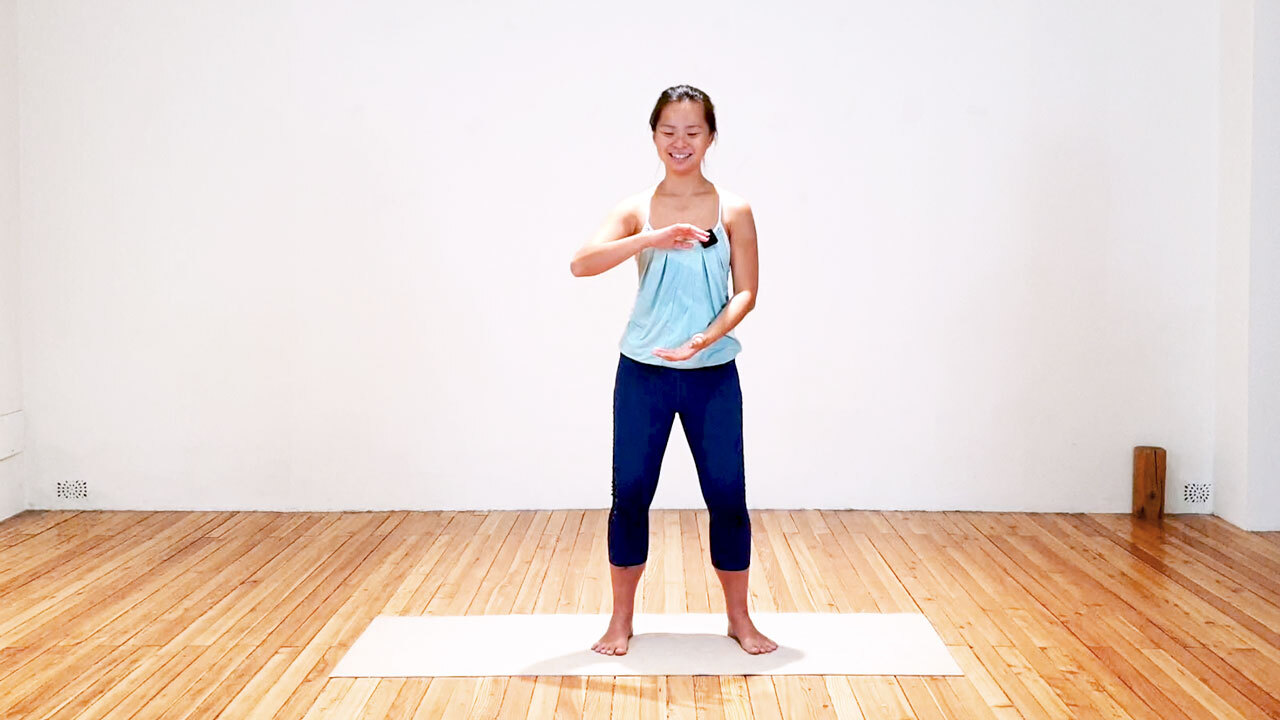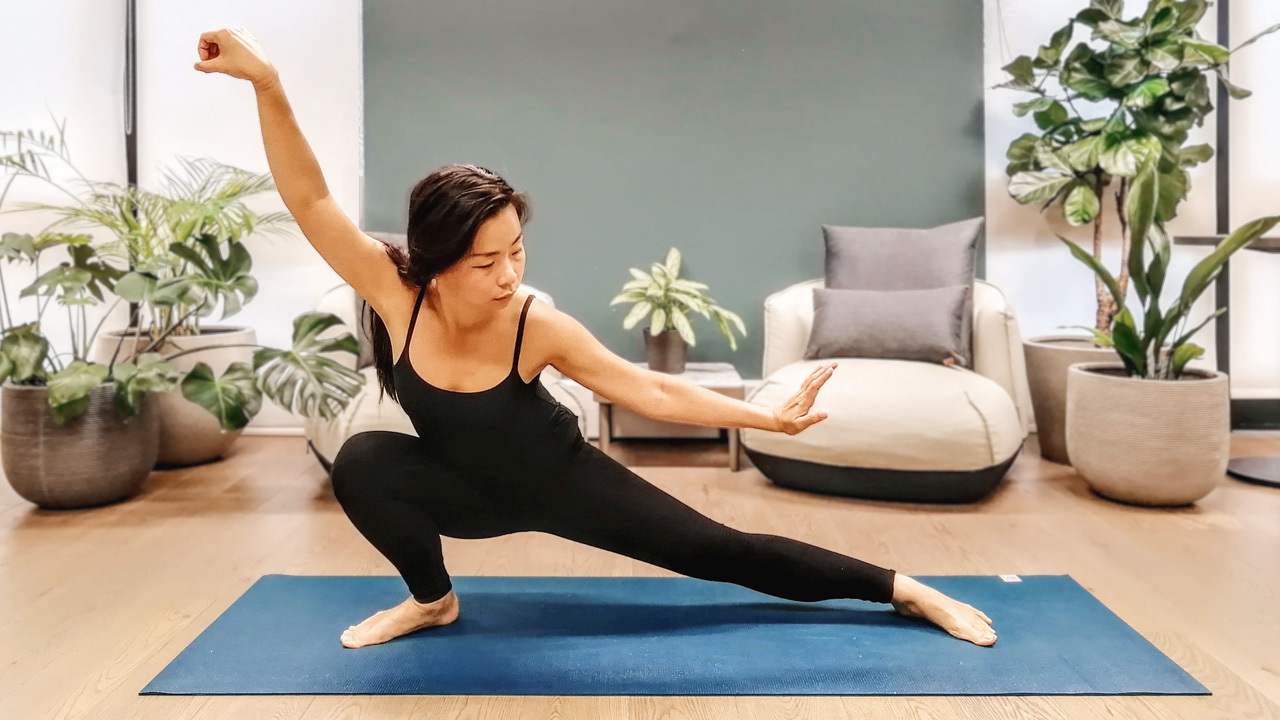What is Qigong?
Qigong is an ancient Chinese practice that involves the cultivation of vital life force energy, or Qi, in the body. It is based on the principles of Traditional Chinese Medicine (TCM) and is often referred to as “Chinese Yoga”. In this article you’ll learn what Qigong is, the history behind Qigong and how it compares to yoga. We’ll also explore the similarities and differences between Qigong and yoga, and how Qigong can benefit you and complement your yoga practice.
Qigong and yoga: Two practices for wholeness
Qigong is similar to yoga in many ways. Both practices involve the cultivation of energy in the body through movement, breath work, and meditation. Both yoga and Qigong are broad terms that encompass a wide range of techniques and practices aimed at cultivating and harnessing the flow of vital life force energy. The term yoga means “to yoke” or “unite” with everything, while Qigong 气功 translates to “energy cultivation.”
The fundamental belief of yoga and Qigong is the existence of a vital life force energy that permeates all beings and processes in the world.
The fundamental belief underlying both yoga and Qigong is the existence of a vital life force energy that permeates all beings and processes in the world. In yoga, this energy is referred to as Prana, while in Qigong, it is called Qi 气. The goal of both practices is to cultivate and promote the flow of this energy through a variety of physical postures, breath techniques, and meditation.
The ultimate objective of Qigong and yoga respectively are to promote health and wellbeing by fostering internal union within each individual. This encompasses the body, mind, and spirit, and promotes union between each individual and the larger whole.
Benefits of Qigong
A clinical study conducted in 2017 found that Qigong can help alleviate various health conditions, including arthritis. A 2015 study described how Qigong can be effective in treating a range of physical and psychological illnesses. TCM views pain, aches, and health problems as manifestations of underlying deficiencies, blockages, or imbalances of Qi in the body. Therefore, Qigong helps by promoting the smooth flow of Qi, the vital life force, through the meridian channels that irrigate the body.
Some commonly cited benefits of Qigong include:
- Balanced energy
- A sense of calm and relaxation (helpful for anxiety and stress)
- Improved balance and coordination
- Improved flexibility and mobility
- Improved overall health, happiness and well-being
Why not give it a try with our guided program?
Cultivate a sense of equilibrium, comfort and clarity in your body, mind and spirit with these simple yet potent practices. Join our Qigong for Clarity & Calm program
The history, roots & origins of Qigong
Yoga and Qigong both have their origins in the East. Yoga is believed to have originated in India over 5,000 years ago. Qigong is at least 4,000 years old and can be traced back to China. The Indian Vedic scriptures, such as the Rig Veda, served as the basis for yoga. Qigong originated from Chinese Daoism. Both practices began as spiritual practices but later underwent modernization.
Yoga was brought to the West by Swami Vivekananda, an Indian teacher who first came to the United States in 1883. He translated yogic texts from Sanskrit to English, organized world conferences, and described yoga as a “science of the mind.” Other prominent teachers, such as Pattabhis Jois, founder of Ashtanga Yoga, and T.K.V. Desikachar, son of Sri Krishnamacharya, also contributed to the rise of yoga in America.
Health and Medical Qigong
In contrast, the first forms of Qigong were practiced by Daoist priests and shamans. These were called Dao Yin 导引, as depicted in the Ma Wang Dui Silk texts map excavated from the tombs in Changsha, Hunan province in China. However, under the ruling government of Mao Zedong in 1950s China, Qigong’s roots with Daoism, Confucianism, and Buddhism were severed. Instead, Qigong was promoted as a health preservation tool, resulting in the emergence of Health Qigong and Medical Qigong. Bill Moyers brought Qigong to the USA through the PBS series Healing and the Mind.
Both yoga and Qigong have undergone significant changes as they have been introduced to different cultures and modernized. However, both practices still share a common goal of promoting health and wellbeing by cultivating and harnessing the flow of vital life force energy in the body.
What are the types of Qigong?
Just like yoga, which has numerous styles and lineages, Qigong also has various types and styles. These include Buddhist Qigong, Health Qigong, Medical Qigong, and Martial Qigong, which includes Taijiquan (Taichi) and Wushu. Qigong can take many forms, including shaking, tapping, stationary stances, and fluid, flowing movements.
When mapped along the spectrum from down-regulating to up-regulating, Yin-Yang or Langhana-Brahmana, Qigong falls on the Yin side. This is because it tends to be slower and more gentle than other practices such as Tai Chi or Ashtanga yoga. However, when compared to Restorative yoga or Yin yoga, which involve static postures with long holds of 3-5 minutes, moving Qigong forms such as shaking, tapping, and flowing movements are faster, more active, and warming.
Key differences between Qigong and yoga
There are several differences between the physical practices of Qigong and yoga. Firstly, most Qigong is done in a standing position, which can be adapted to a seated position, while yoga poses can be done on the floor, in a chair, or standing.
Secondly, yoga styles like Hatha, Restorative, and Yin yoga tend to focus more on static holds, while Qigong forms often involve shaking, tapping, and flowing movements that feel like moving meditation. Qigong also places a greater emphasis on spiraling movements that cut across different planes, whereas yoga poses tend to be more linear. However, due to the wide range of practices within each discipline, there is diversity in both.
For example, some forms of yoga, such as Ashtanga or Vinyasa Flow, can be very fluid and feel like moving meditation. Meanwhile, some Qigong forms are static with a focus on internal energy and breath. Lastly, Qigong stances tend to have a softer, more rounded appearance compared to the more structured poses of yoga.
Subtle Body maps of Qigong and yoga
Yoga and Qigong are associated with different medical systems. Yoga is linked with Ayurvedic medicine, one of the world’s oldest medical systems from India. Qigong is rooted in Traditional Chinese Medicine.
The invisible energy channels that flow through the body are called nadis in yoga and meridian channels or JingLuo 经络 in Qigong. Both systems also recognize the presence of concentrated energy vortexes within these channels. In yoga, these are called the 7 Chakras, while in Qigong, they are the 3 Dantian 丹田, as shown below.
The Five Elements in yoga and Qigong
Qigong and yoga are both based on their respective Five Elements Theory. These include Traditional Chinese Medicine’s Five Moving Forces WuXing 五行 and Ayurveda’s Panchamahabhuta. These dominant energies are believed to underpin the seasons and cycles, and are fundamental to each system’s philosophy.
Both systems have additional associations beyond the Five Elements Theory. In yoga and Ayurveda, the Five Elements are linked with the five Koshas, seven Chakras, and five Vayus. Conversely, in Qigong and Traditional Chinese Medicine, the Five Elements are associated with emotions, virtues, numbers, organs, and so on. A comprehensive list of the Five Elements Relationships in TCM/Qigong can be found here.
According to Qigong which is rooted in TCM philosophy, individuals are a microcosm of the universe. Everything found in nature can also be experienced within an individual’s internal landscape. To achieve a healthy, happy, and long life, one must align with nature by embodying the balance of YinYang – two opposing and complementary forces that underpin all phenomena – and by flowing with the Five Elements, which are the five moving forces that drive the unfolding of all phenomena, such as the seasons.
Qigong and yoga: a philosophy for living
Both yoga and Qigong prioritize balancing effort with ease. In the Yoga Sutra 2.46, “sthira sukham asanam,” the posture for meditation should be steady, stable, and comfortable. Similarly, in Qigong, practitioners are encouraged to embody WuWei, meaning engaging in action without unnecessary striving, or effortless action.
Moreover, both Qigong and Yoga emphasize the importance of non-attachment to achieve spiritual liberation. In yoga, this is known as Karma yoga. This involves rightful action without being attached to the outcome or being influenced by potential results. In Qigong, this is achieved by flowing with the Dao. This means ‘taking the rightful way, path, speech, and method in life’.
How Qigong can complement your yoga practice
Both yoga and Qigong offer unique benefits and approaches to physical, mental, and spiritual well-being. It is not necessary to choose one over the other – try both and see which works best for you. While Qigong may complement your yoga practice, it can also stand alone as a mindfulness and self-cultivation practice.
Incorporating Qigong’s diverse forms, including tapping, shaking, and spiraling flowing movements, has been a valuable addition to my yoga practice. Practicing Qigong has helped me recover from sciatica pain, and improve my mobility, balance, and spatial awareness. It empowered me to become more attuned to my energy and the energy of others and the world around me. These benefits have also enriched my yoga, meditation, and mindfulness practice, and have positively impacted my life overall.
By incorporating Qigong into your yoga practice, you can deepen your understanding of energy and cultivate a deeper sense of awareness in your body. This can help you to approach your yoga practice with a greater sense of mindfulness and intention, and can lead to a deeper sense of connection with your body and your practice.


